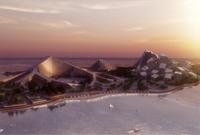On the sustainability of ecological model cities

This is similar to the case of the Masdar “Eco City” that is currently being realised in the desert landscape 30 km to the east of Abu Dhabi following plans by Norman Foster (ill. 4). In the future, 50,000 residents will live in the densely constructed, car-free city constructed on the basis of traditional Arab settlement patterns and housing 1,500 enterprises. In any case, the notion of sustainability forms the foundation for the entire econ¬omy and a university will also devote itself primarily to this most complex of subjects. Whether this can really be achieved in a settlement area of this magnitude – the area covers six square kilometres – remains to be seen.
The “Zira” resort, which the Danish BIG team (Bjarke Ingels Group) is planning for an island just off the coast in the bay of Baku in the Caspian Sea, is a case in point (ill. 1, 2). It is planned to construct seven mountains of housing – in reference to the seven most distinctive mountains in Azerbaijan – on an area of one square kilometre. The architects describe their concept as “high-end living with low-end resource usage”. Heat pumps provide energy supply from the sea, in addition to solar panels, photovoltaic parks and an offshore wind power plant on converted oil rigs; recycling and waste water processing guarantee the minimum consumption of resources. There is no denying that this extremely problematic combination of luxury apartments, a marina and leisure resort is rooted in the spirit of speculative real-estate business. In other words, doing without this settlement model would clearly be more ecological than any kind of sustainable trimmings.
A serpentine construction area, whose layout reminds one of Le Corbusier’s plan for Algiers and Emile Aillaud’s large-scale developments in the Parisian banlieues, winds its way around the hills of Montecorvo and La Fonsalada in Spain’s La Rioja wine-growing region (ill. 4).
Although some formal aspects are reminiscent of concepts from the 1940s to 1970s, MVRDV’s plans for a new district in the north of Logroño can claim to play a pioneering role in the urban construction of the future. The 3,000 housing units that follow the guidelines of social housing construction are not simply scattered over the landscape, on the contrary, in their compactness, they only take up 10% of the total area. Photovoltaic parks in the park beneath, and wind power plants on the hill above the settlement are intended to guarantee a CO2-neutral supply of energy.
This makes Logroño Montecorvo an example of those “eco-cities” that are currently being planned in various locations around the world. In an age of climate change, planning cities according to the criteria of sustainability has become conceivable. However, one must be wary that the “eco” prefix is not simply a kind of lubricant that makes it easier to slip hypertrophic urban visions past political decision makers.
